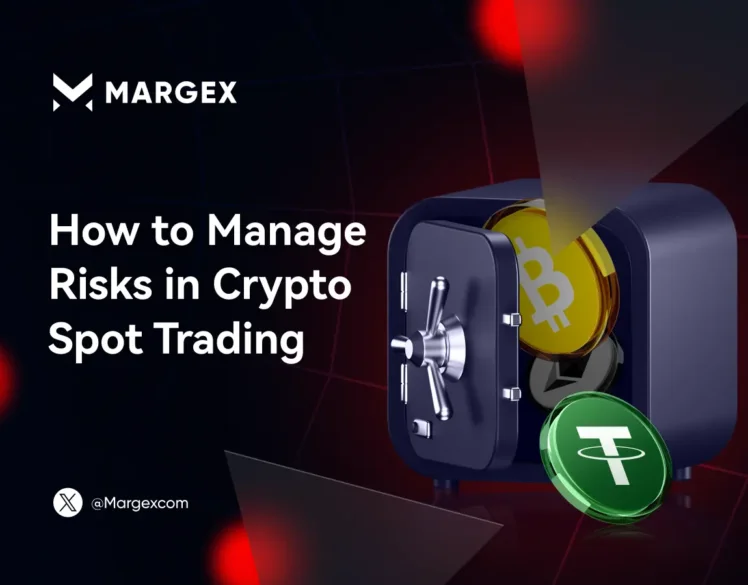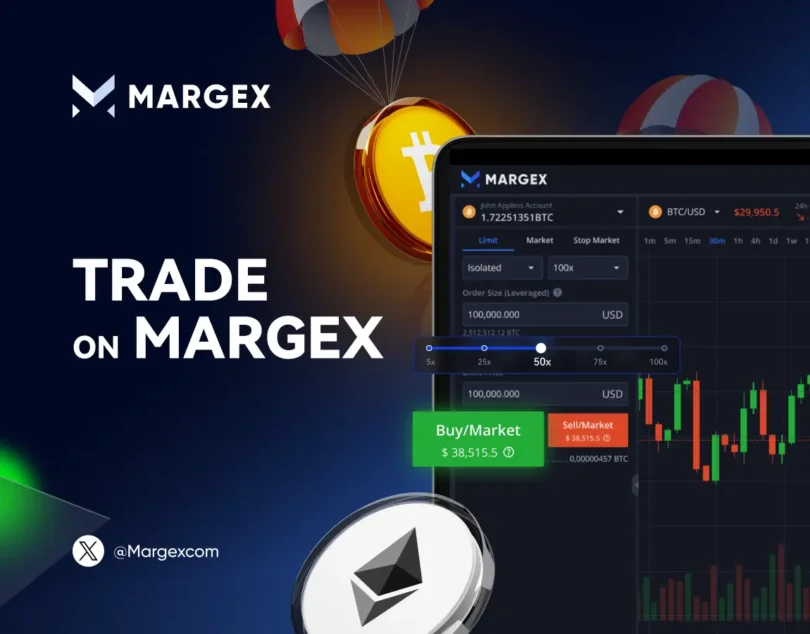How to Manage Risks in Crypto Spot Trading

Managing risk is the backbone of sustainable returns in digital markets. Effective risk management in crypto trading helps traders limit losses, protect capital, and build long‑term confidence. Without a clear framework, volatile price swings and unexpected events can wipe out gains in moments. This article offers a structured approach to risk management in crypto trading, covering key principles, technical controls, and practical tips for a balanced strategy.
Key Takeaways
- Risk management is crucial in crypto to preserve capital and avoid emotional trading.
- Position sizing, risk–reward ratios, and stop-loss orders are fundamental tools.
- Use cold wallets and secure private keys to protect long-term holdings.
- Always diversify and monitor your portfolio to minimize correlated risks.
- Only trust reputable exchanges like Margex for executing trades.
Why Risk Management Matters?
- Volatility Control: Cryptocurrency markets can swing 10% or more in a day. Applying risk management in crypto trading prevents emotional decisions when prices surge or crash.
- Capital Preservation: The main goal of capital preservation involves protecting the money designated for trading purposes. While all forecasts eventually fail, some strategies serve to maintain a trader position during challenging times.
- Consistent Growth: The preservation of your initial capital lets you make steady compounded investments. Strategic discipline creates the ability to stay clear of the market cycle that occurs with speculative traders who use too much leverage.
Core Principles
- Position Sizing: Limit each trade to a small percentage of your total balance—typically 1–3%. This is a cornerstone of crypto risk management, ensuring one bad trade can’t devastate your account.
- Risk‑Reward Ratio: Establish trading positions that offer rewards at least two times greater than possible risks. Evaluate trade risk by determining entry point and stop loss and target that will determine if the specified risk exposure is justified.
- Risk analysis: Permanent risk analysis is a prerequisite for every trade, which requires examination of market volatility levels together with liquidity conditions and recent news events. Assess the possible implications of these elements on the position you maintain.
- Risk assessment: Conduct risk assessment at the portfolio level to start. Judge your complete risk exposure to correlation and leverage and sector concentration before committing to adding new positions.
Techniques for Blockchain Risk Management
| Technique | Description | Benefit |
|---|---|---|
| Position Sizing | Limit trade size to 1–3% of account balance |
Protects capital from major loss |
| Risk–Reward Ratio | Target returns ≥2x of potential loss |
Ensures risk is justified by reward |
| Smart-Contract Audits | Verify DeFi protocols are tested | Reduces technical vulnerabilities |
| Cold Storage | Use offline hardware wallets | Protects from online threats |
| Multi-Signature Wallets | Require multiple approvals for large transactions |
Prevents unauthorized access |
- Smart‑Contract Audits: You must verify that all DeFi protocols along with new tokens have undergone third-party security testing before engaging with them. Audits protect smart contracts from hacker intrusion and system bugs during operation.
- Cold Storage Practices: The main portion of your cryptocurrency assets should reside in hardware wallets which store them offline. Online threats including phishing and exchange failures are prevented through the application of blockchain layers and risk management systems.
- Multi‑Signature Solutions: Large transfers within the platform must gain approval from multiple designated management representatives. The multi-signature wallet system provides enhanced defense capabilities, which make it essential for blockchain risk management when protecting teams and high-net-worth accounts.
How To Secure Your Crypto?
- Choose the Right Wallet Type
What type of wallet you select depends on the use of your cryptocurrency. People who make numerous transactions must use a hot wallet because it connects to the internet. Online wallets do not provide the best security for large cryptocurrency storage, therefore cold wallets (offline storage) remain the better solution.
Hot wallets exist as mobile phone or computer applications that provide easy access but maintain exposure to dangers found on the internet. Cold wallets which come in hardware or paper format do not need online functionality to operate. The hardware wallet functions as a small physical device resembling a USB drive, and a paper wallet consists of a printed sheet with wallet key information.
Store your daily usage funds in hot wallets, but move the bulk amount for security into cold storage. The storage of wallet credentials should include backup procedures, especially during cold wallet management. The lack of understanding your access credentials could lead to permanent fund loss when you forget your password or lose your device.
- Secure Your Private Keys
Your ability to control digital assets as well as access them is controlled entirely by private keys. A person who acquires possession of your key obtains unrestricted access to manage your financial assets. All private keys must remain out of your email account and notes app, as well as away from online storage services.
Put your private key down on paper, then place it into a safe storage method such as a locked drawer or safety deposit box. Avoid taking photos of your keys, because image viewing functions exists through phone systems as well as cloud storage backup.
Make sure you store multiple copies of your private key at different physically safe locations. The multiple storage of your private keys ensures your assets remain accessible even when one copy becomes unavailable. The places where you store your backup keys should remain secure against fire damage, water damage and theft incidents.
- Use Hardware Wallets for Maximum Safety
Your cryptocurrency keys exist physically in hardware wallets which need manual verification to execute transactions. The offline state of hardware wallets during normal operation makes them immune to the majority of online threats.
Several popular hardware wallet options are Ledger Nano S and Ledger Nano X together with Trezor. The security solutions built into these devices include various protective measures and performs data recovery in lost situations. These devices back multiple digital currencies and function as safe storage devices because of their long-term operational capabilities.
- Use Reputable Exchanges Only
You must choose exchanges which possess proven reputations and official licenses, like Margex. Stay away from sellers who have weak or no regulation because their security cannot be verified. The selection of a secure platform depends on three essential elements: being transparent to users, providing high-quality customer assistance, and implementing secure processes.
User reviews and regional financial compliance status must be confirmed before investing in any exchange. Moving your funds through legitimate platforms minimizes the possibility of fraudulent activities as well as unauthorized fund transfers and losses.
Diversifying Your Cryptocurrency Portfolio
| Wallet Type | Connectivity | Security Level | Best Use |
|---|---|---|---|
| Hot Wallet | Online (mobile/desktop apps) | Moderate | Daily transactions |
| Cold Wallet | Offline (hardware or paper) | High | Long-term storage |
| Hardware Wallet | Offline, with USB access | Very High | Securing large holdings |
| Paper Wallet | Fully offline (printed) | High, if stored securely |
Backup or legacy storage |
A well‑constructed cryptocurrency portfolio spreads risk across assets with different use cases and liquidity profiles:
- Blue‑Chip Coins (e.g., Bitcoin, Ethereum) for stability
- Layer‑1 and Layer‑2 Tokens to gain exposure to network growth
- Stablecoins as dry powder for quick deployment
- DeFi & NFT Projects at modest allocations to capture innovation without overexposure
Rebalance periodically—monthly or quarterly—to lock in gains and limit drift. Proper diversification is a core tenet of long‑term success.
Tools and Best Practices
- Automated Stop‑Loss Orders
Use exchange features or trading bots to enforce exit rules. Automated orders prevent emotional overrides in fast markets. - On‑Chain Analytics
Platforms that track large token movements and liquidity pools provide early warnings for unusual activity. - Performance Tracking
Maintain a trading journal. Record entry, exit, rationale, and outcome for every trade. Over time, patterns in winning and losing setups become clear.
Conclusion
Robust risk management in crypto trading is essential for surviving digital markets and achieving consistent gains. By combining position sizing, risk‑reward analysis, technical safeguards, and diversified portfolio design, traders can mitigate common pitfalls. Remember: preserving capital during downturns is just as important as capturing upside in rallies.
FAQ
What are the 5 steps of risk management?
- Identify risks in the market or strategy.
- Analyze potential impact and likelihood.
- Assess by prioritizing risks based on severity.
- Treat risks through avoidance, reduction, transfer, or acceptance.
- Monitor and review controls to adapt to new information.
How to calculate risk management crypto?
- Determine your maximum acceptable loss per trade (e.g., 2% of account).
- Calculate stop‑loss distance: difference between entry and stop price.
- Position size = (Account size × Risk per trade) ÷ Stop‑loss distance.
- Adjust based on volatility and correlation with other positions.
What are the risks in cryptocurrency?
- Market Risk: Price volatility and rapid swings.
- Technical Risk: Smart‑contract flaws and protocol bugs.
- Operational Risk: Exchange hacks, wallet errors, or phishing.
- Regulatory Risk: Policy changes impacting access or classification.
What is risk management in trading?
Risk management in trading is the process of identifying and mitigating potential losses through techniques like position sizing, stop‑loss orders, diversification, and ongoing review. It balances reward potential against downside exposure to protect capital and support sustainable growth.


